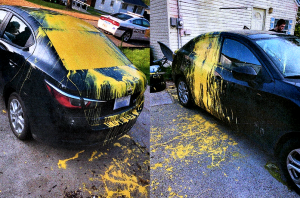 Don’t use dangerous solvents such as lacquer thinner, enamel reducer, acetone, or some other similar solvent that could severely damage your vehicle’s paint, cleacoat, trim, and moldings. Our safe method of removal is: to wash the vehicle first and then apply a lubricant to those areas covered by the paint contamination. Then our highly skilled technician would take a specially prepared blade and safely glide it over the lubricated surfaces and shave off the paint contamination. No marks are left on the shaved surfaces from this safe process.
Don’t use dangerous solvents such as lacquer thinner, enamel reducer, acetone, or some other similar solvent that could severely damage your vehicle’s paint, cleacoat, trim, and moldings. Our safe method of removal is: to wash the vehicle first and then apply a lubricant to those areas covered by the paint contamination. Then our highly skilled technician would take a specially prepared blade and safely glide it over the lubricated surfaces and shave off the paint contamination. No marks are left on the shaved surfaces from this safe process.
This same process is used on vehicle surfaces heavily oversprayed by industrial paints such as: epoxies, urethanes, and roofing foams. These often originate from the painting of : water towers, storage tanks, high rise commercial buildings, bridges, communication towers, and the painting of lines on the road.
Auto body shops will often wet-sand heavy dense overspray from vehicle surfaces and then machine polish off the sanding scratches at high costs. Unfortunately, this process severely diminishes the life expectancy of a vehicle’s original factory paint and clear coated surfaces, all of which are only a few mills thick. The use of clay bars, which are equivalent to two to three thousand grit sandpaper will also damage a vehicle’s original paint and clear coated surfaces from being heavily rubbed back and forth many times to sand away the heavy overspray contamination. This sanding process is not recommended.
Our company, Overspray Removal Specialists, Inc. has the safe state of the art technology to restore any oversprayed vehicle back to its original state prior to an overspray incident.
We have successfully removed overspray from an estimated 300,000 vehicles over our 53 years of business, and our mobile crews, if needed, can do the same for you at your location anywhere in the nation. We also specialize in handling overspray claims for insurance companies and painting contractors.
